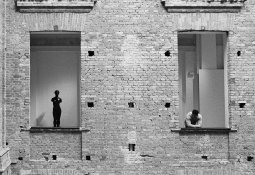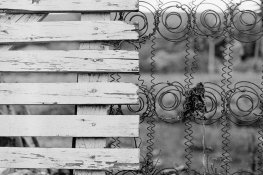luizjorgemn
Member
- Joined
- Aug 17, 2011
- Messages
- 35
- Format
- Multi Format
Hello all. My name is Luiz and I´m from Brazil. This is my first thread at APUG, so I´m a bit nervous about my poor English. I wonder if you all will even understand what I´m writing about. In advance I´m sorry for my spelling and grammar mistakes.
I´m using Eastman Kodak Double-X since 2010 and feels very happy with the results. I used to develop it with D96 but now I´m trying it with other chemicals, as I had some rolls scratched in my bulk loader (bad technique, I confess).
First of all I was using D23 plus water bath, with not-so-nice results. Now I got all chemistries and tryed it with Diafine formula provided at Anchell´s Darkroom Cookbook. We don´t have the original Diafine here in Brazil. These are the results I got from my test.
I think it´s not necessary to write about this developer as you all may know it, but for those who aren´t aware of Diafine, this is a good review: http://www.blackandwhitefineart.net/2011/01/diafine/
The negative is a well-known movie negative used in movies like Schindler´s List and 007 Casino Royale, for example. Having a ISO about 250, it´s not a all-around film but I´m looking for a cheaper substitute for Tri-X (US$ 15,00/36 exp roll in Brazil). As this film is thicker than most of negatives (has 2 extra protective layers) I thought it would be a nice candidate for Diafine, that requires the negative to be soaked in bath A to be developed by the alkali in bath B. So, let´s give it a try!
The negative was developed for 4 minutes in every solution and the agitation scheme was 30s initially and 2 inversions every 30s for bath A and 2 inversions every minute in bath B. Don´t ask why I made it different, just seemed to be the right thing to do.
This is the test. I shoot with a Pentax ME Super and a 50 1.4 lens, metered in-camera. The scan is a Plustek Opticfilm 7400 with Vuescan, 2400 DPI, one pass.
A) MDF board (don´t know if you imagine what´s this, it´s a wood-like board used in furniture here in Brazil), metered as medium-gray (zone 5) and closed 2 stops (to zone 3), to see if the negative could retain all details. The intention was to verify the developer´s push capacity. All images are straight out the scan (less contrasted and darker than normal) but there is margin for post-processing on all of them, because there aren´t clipped shadows.
1. ISO 200

2. ISO 400

3. ISO "600" (half-stop between 400 and 800, that´s all my lens could do)

4. ISO 800

5. ISO "1200" (half-stop between 800 and 1600)

6. ISO 1600

Conclusion: Nice detail retention till "1200" and usable till 1600. Very good for a 250 ISO negative.
B) Low contrast situation: I would like to see detail retention in bright places, grain size/shape, details in darker places and where I could get the most pleasant contrast curve/ISO. Images edited just to get more pleasant, simulating a real world film situation usage.
1. ISO 400

2. ISO 800

3. ISO 1600

Conclusion: Low contrast scenes with bright tones predominance could be shooted till ISO 1600. Those situations might not need high ISOS (there is enough light) but we may use ISO 1600 and close the diafragm for depth of field control or high speeds for moving subjects. The best contrast curve was at ISO 800, and the grain was less dominant till 800 also. Again, 1600 might be used.
I´m using Eastman Kodak Double-X since 2010 and feels very happy with the results. I used to develop it with D96 but now I´m trying it with other chemicals, as I had some rolls scratched in my bulk loader (bad technique, I confess).
First of all I was using D23 plus water bath, with not-so-nice results. Now I got all chemistries and tryed it with Diafine formula provided at Anchell´s Darkroom Cookbook. We don´t have the original Diafine here in Brazil. These are the results I got from my test.
I think it´s not necessary to write about this developer as you all may know it, but for those who aren´t aware of Diafine, this is a good review: http://www.blackandwhitefineart.net/2011/01/diafine/
The negative is a well-known movie negative used in movies like Schindler´s List and 007 Casino Royale, for example. Having a ISO about 250, it´s not a all-around film but I´m looking for a cheaper substitute for Tri-X (US$ 15,00/36 exp roll in Brazil). As this film is thicker than most of negatives (has 2 extra protective layers) I thought it would be a nice candidate for Diafine, that requires the negative to be soaked in bath A to be developed by the alkali in bath B. So, let´s give it a try!
The negative was developed for 4 minutes in every solution and the agitation scheme was 30s initially and 2 inversions every 30s for bath A and 2 inversions every minute in bath B. Don´t ask why I made it different, just seemed to be the right thing to do.
This is the test. I shoot with a Pentax ME Super and a 50 1.4 lens, metered in-camera. The scan is a Plustek Opticfilm 7400 with Vuescan, 2400 DPI, one pass.
A) MDF board (don´t know if you imagine what´s this, it´s a wood-like board used in furniture here in Brazil), metered as medium-gray (zone 5) and closed 2 stops (to zone 3), to see if the negative could retain all details. The intention was to verify the developer´s push capacity. All images are straight out the scan (less contrasted and darker than normal) but there is margin for post-processing on all of them, because there aren´t clipped shadows.
1. ISO 200

2. ISO 400

3. ISO "600" (half-stop between 400 and 800, that´s all my lens could do)

4. ISO 800

5. ISO "1200" (half-stop between 800 and 1600)

6. ISO 1600

Conclusion: Nice detail retention till "1200" and usable till 1600. Very good for a 250 ISO negative.
B) Low contrast situation: I would like to see detail retention in bright places, grain size/shape, details in darker places and where I could get the most pleasant contrast curve/ISO. Images edited just to get more pleasant, simulating a real world film situation usage.
1. ISO 400

2. ISO 800

3. ISO 1600

Conclusion: Low contrast scenes with bright tones predominance could be shooted till ISO 1600. Those situations might not need high ISOS (there is enough light) but we may use ISO 1600 and close the diafragm for depth of field control or high speeds for moving subjects. The best contrast curve was at ISO 800, and the grain was less dominant till 800 also. Again, 1600 might be used.

















 My notes don't say so but I suspect I shot this using the in-camera meter, which is quite old now and not always accurate.
My notes don't say so but I suspect I shot this using the in-camera meter, which is quite old now and not always accurate.









